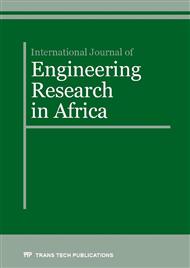[1]
D. K. Pal and S. K. Basu, Hot machining of austenitic manganese steel by shaping, International Journal of Machine Tool Design and Research, vol. 11, (1971)45-61.
DOI: 10.1016/0020-7357(71)90046-1
Google Scholar
[2]
K.P. Maity and P.K. Swain, An experimental investigation of hot machining to predict tool life, Journal of Materials Processing Technology, vol. 198, (2008) 344–349.
DOI: 10.1016/j.jmatprotec.2007.07.018
Google Scholar
[3]
V. Raghuram and M.K. Mujo, Improving tool life by magnetization in hot machining, Machine Tool Design and Research, (1980) 87–96.
DOI: 10.1016/0020-7357(80)90021-9
Google Scholar
[4]
N.N.S. Chen and K.C. Lo, Factors affecting tool life in hot machining of alloy steels, International Journal of Machine Tool Design, vol. 14, (1974)161-173.
DOI: 10.1016/0020-7357(74)90024-9
Google Scholar
[5]
B.K. Hinds and S.M. DE Almedia, Plasma archeating for hot machining, International Journal of Machine Tool Design, Vol. 21, (1981) 143-152.
DOI: 10.1016/0020-7357(81)90005-6
Google Scholar
[6]
T. Kitagaea and K. Maekawa, Plasma hot machining for new engineering materials, Wear, vol. 139, (1990) 251-267.
DOI: 10.1016/0043-1648(90)90049-g
Google Scholar
[7]
G. Madhavulu and B. Ahmed, Hot machining process for improved Metal Removal Rates in turning operations, Journal of Materials Processing Technology, vol. 44, (1994) 199-206.
DOI: 10.1016/0924-0136(94)90432-4
Google Scholar
[8]
Carl E. Leshock, Jin-Nam Kim and Yung C. Shin, Plasma enhanced machining of Inconel 718: modeling of work piece temperature with plasma heating and experimental results, International Journal of Machine Tools & Manufacture , vol. 41, (2001).
DOI: 10.1016/s0890-6955(00)00106-1
Google Scholar
[9]
V. Upadhaya, P. K Jain, and N.K. Mehta, Machinability studies in hot machining of Ti-6Al-4V, Advanced Materials Research. vols. 622-623 (2013) 361-365.
DOI: 10.4028/www.scientific.net/amr.622-623.361
Google Scholar
[10]
M. Baili, V. Wanger and G. Dessein, An experiment investigation of hot machining with induction to improve Ti-5553 machinability, Applied Mechanics and Materials. Vols. 62 (2011) 67-76.
DOI: 10.4028/www.scientific.net/amm.62.67
Google Scholar
[11]
S. Ranganathan and T. Senthilvelan, Optimizing the process parameters on tool wear of WC insert when hot turning of AISI 316 stainless steel, ARPN Journal of Engineering and Applied Sciences, (2010).
Google Scholar
[12]
S. Ranganathan and T. Senthilvelan, Multi-response optimization of machining parameters in hot turning using Grey analysis, International Journal of Advanced Manufacturing Technology, vol. 56, (2011) 455-462.
DOI: 10.1007/s00170-011-3198-5
Google Scholar
[13]
A. Sadhu and S. Chakraborty, Non-traditional machining process selection using data envelopment analysis (DEA), Expert Systems with Applications, 38 (2011) 8770-8781.
DOI: 10.1016/j.eswa.2011.01.088
Google Scholar
[14]
J. Sahu, C. Mohanty, and S. S. Mohapatra, A DEA approach for optimization of multiple responses in electric discharge machining of AISID2 steel. Procedia Engineering 51 (2013) 585-591.
DOI: 10.1016/j.proeng.2013.01.083
Google Scholar
[15]
K. G. Prasad, M.V. Prasad, A. C. Rao and P.V.S.C. Manjusha, DEA-based taguchi method for optimization of CNC end milling process parameters, International Journal of Emerging Trends in Engineering and Development. Vol. 4 (2013) ISSN 2249-6149.
Google Scholar


